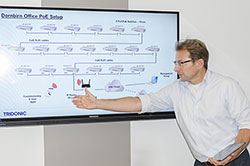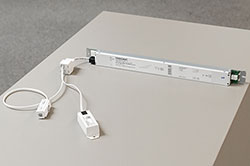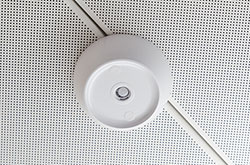Tridonic Toolbox net4more:
Successful practical test at company headquarters
Location: Dornbirn/Austria
Products: , net4more
A total of 200 devices, including presence detectors and sensors for measuring air quality and illuminance, have been installed by Tridonic at the company’s headquarters. net4more connects the individually connected devices both using cables via Power over Ethernet (PoE) and wirelessly using Thread. A particular advantage: The solution can be scaled and extended as required.
During the pilot installation of net4more, Tridonic is using the existing light infrastructure at the company premises as a carrier technology. The individual sensors are connected to the luminaires and form a network that is connected to the internet and to which other devices can easily be added. The Toolbox integrates all possible components such as LED drivers, communication modules, sensors and communication infrastructure on a single platform, and makes the captured data on the connected devices available for analysis and checking purposes, with the help of an open interface. Power is supplied via conventional mains power cables or Ethernet (Power over Ethernet / PoE).
Data on occupancy, air quality and illuminance captured by the sensors is displayed in a heat mapping application. Parameters such as the occupancy of the rooms as a percentage, the amount of carbon dioxide and particulate matter in the air or the energy consumed by luminaires are clearly displayed in graphic form, and transmitted to and stored in cloud applications at hourly intervals.
Tridonic uses the presence data to create detailed profiles on the use of the various rooms, for example, which can be used as a basis for developing specific measures for alternative room occupancy plans. The air quality data is used as a standard against which the optimum control of the air conditioning system is measured, in order to achieve the defined standard values of the breathable air. Building technicians can use the power consumption data to see peak loads and take appropriate measures.
Data on occupancy, air quality and illuminance captured by the sensors is displayed in a heat mapping application. Parameters such as the occupancy of the rooms as a percentage, the amount of carbon dioxide and particulate matter in the air or the energy consumed by luminaires are clearly displayed in graphic form, and transmitted to and stored in cloud applications at hourly intervals.
Tridonic uses the presence data to create detailed profiles on the use of the various rooms, for example, which can be used as a basis for developing specific measures for alternative room occupancy plans. The air quality data is used as a standard against which the optimum control of the air conditioning system is measured, in order to achieve the defined standard values of the breathable air. Building technicians can use the power consumption data to see peak loads and take appropriate measures.


